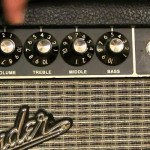Language
Guitar Amp Settings Explained
Figuring out how guitar amplifiers work can be a tough proposition for beginners. Yes, it's not too hard to figure out what Bass, Mid, and Treble will do but when you start mixing them together or you're trying to dial in a specific sound, it can be a bit much if you're a new player. With that in mind, we take a look at basic amp settings, what exactly they do, and tips on how to dial in your desired tone.
 Quilter Labs Mach 2 8-inch Combo Amp Review[/caption]
[caption id="attachment_1945" align="alignleft" width="150"]
Quilter Labs Mach 2 8-inch Combo Amp Review[/caption]
[caption id="attachment_1945" align="alignleft" width="150"] Ampeg BA-112 v2 Combo Bass Amplifier Review[/caption]
[caption id="attachment_1995" align="alignleft" width="150"]
Ampeg BA-112 v2 Combo Bass Amplifier Review[/caption]
[caption id="attachment_1995" align="alignleft" width="150"] Great Guitar Amps For Classic Rock[/caption]
Great Guitar Amps For Classic Rock[/caption]
Startup Amp Settings for Beginners
Now, whether or not you are familiar with guitar pedal reviews, I can tell you from doing them myself that a good way to begin to figure out a brand new product is by placing the settings at their midpoint and go from there. For amplifiers, on the other hand, you will want to start off with the settings on their “flat” position. This is because unlike guitar pedals which best understood by getting a feel for the way they apply effects, guitar amps can be best understood by familiarizing yourself with their true sound, that is to say, how it sounds with all of the EQ settings on their flat (or off) position. As an interesting side note, you might have (or not) noticed that the flat position for EQ knobs are at their 12 o’clock position while those for volume and drive/gain are not (they’re usually at 6 o’clock). Interesting side notes aside, always start with this flat EQ setting when trying to determine a specific tone you are looking for, that way you can hear exactly how each setting affects the overall sound and you won’t have to blindly mess around with knobs when trying to find another specific tone.Distortion Balance and Adding Some EQ
Alright, so now that you have everything in the flat position and are able to hear the true sound of the amplifier, you can begin to add some EQ. By now, you should have placed the volume at your appropriate listening level. If you are looking for a distorted tone, give that gain a bit of a boost until you’re satisfied with the overall sound. If you will be looking for a completely clean tone, leave the gain off altogether. Now that you have your balance of clean and distorted figured out, we can begin to add some EQ to the sound. The first EQ setting you should focus on will be the Bass knob as this will be hardest to distinguish of the common three settings if not set first. More bass will give your tone a thicker sound while less will leave it thin. Once you find the appropriate body for your tone, the mid range should be next. The more mid you give your tone, the more it can cut through other instruments in the mix but remember, it is a good idea to be a bit more conservative with the mid settings because most vocals usually fall on this side of the spectrum and too much mid can begin to overpower them. Alright, and finally, the treble setting will be used to give your tone your desired amount of brightness or plenty of more bite when used with distortion. If you would like something that sounds a bit darker, keep the treble a bit low.Final Thoughts ...
Although there is no true right or wrong way in figuring out amp settings for your preferred tone, following these simple steps is by far the easiest way to not only find your desired sound, but lets you start getting a feel for not only how each of these settings individually affect the overall tone, but you will be able to gain an understanding of your amps true sound as well. While this is simply just the beginning when it comes to amplifier settings, it is definitely a good place to start.Your Turn to Sound Off!
Are there any other amp settings that give you trouble? What are they?Let us know in the comment section below!
Other Stories You Might Like ...
[caption id="attachment_7406" align="alignleft" width="150"] Quilter Labs Mach 2 8-inch Combo Amp Review[/caption]
[caption id="attachment_1945" align="alignleft" width="150"]
Quilter Labs Mach 2 8-inch Combo Amp Review[/caption]
[caption id="attachment_1945" align="alignleft" width="150"] Ampeg BA-112 v2 Combo Bass Amplifier Review[/caption]
[caption id="attachment_1995" align="alignleft" width="150"]
Ampeg BA-112 v2 Combo Bass Amplifier Review[/caption]
[caption id="attachment_1995" align="alignleft" width="150"] Great Guitar Amps For Classic Rock[/caption]
Great Guitar Amps For Classic Rock[/caption]
